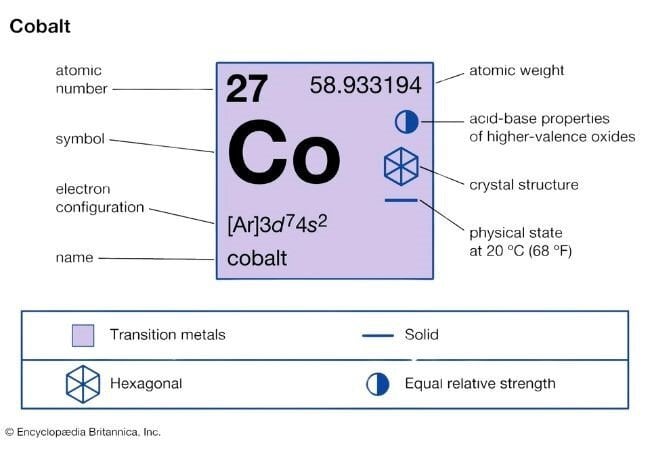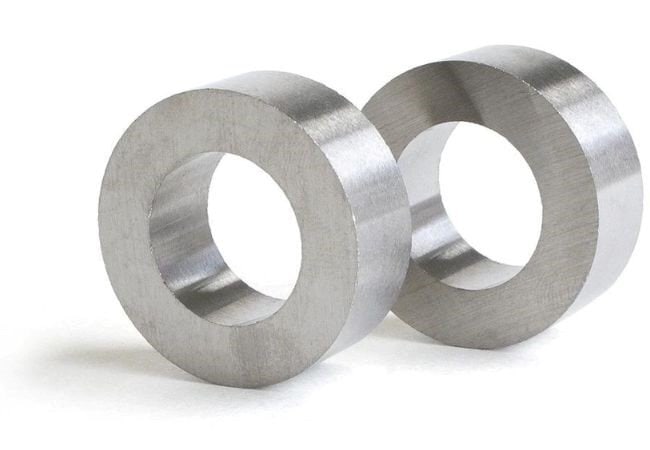Yes, cobalt (Co) is a magnetic material. It is one of the naturally occurring ferromagnetic materials. Other ferromagnetic metals include nickel (Ni), iron (Fe), Gadolinium (Gd), Dysprosium (Dy) and Terbium (Tb)
But what is so unique about cobalt magnetism or its properties?
That is exactly what we shall focus on in this guide.
Cobalt is a Naturally Magnetic Material

Ferromagnetic materials are known for their unique behavior when you subject them to any magnetic field. That is to say, ferromagnetism is characterized by:
- Magnetic permeability
- Ability to become permanent magnets
- High attraction to magnets
- Easy to induce magnetism
Cobalt is a naturally occurring ferromagnetic material. Therefore, it is naturally a magnetic material.
Within cobalt, there are atomic dipoles that are aligned in the same direction. Therefore, even in the absence of any magnetic field, cobalt domains experience a net magnetic moment.
However, it is worth noting that even within cobalt, the magnetic moment in the neighboring domains can be facing different directions. This can result in canceling out the total magnetic moment. However, by applying just a small magnetic field, they easily orient to form permanent magnets.
Additionally, the above phenomenon is due to the unique arrangement of electrons in cobalt. In cobalt’s d orbital, there are three unpaired electrons. It is the unpaired electrons that contribute to the cobalt magnetic property.
Cobalt Structure vs. Magnetism

Naturally, cobalt exists in two main crystallographic structures. That is the:
- Face-centered cubic (FCC) structure
- Hexagonal close-packed (HCP) structure
These structures alongside the electron configuration contribute to cobalt magnetism. Even in its pure form, cobalt has a strong magnetic moment. With this unique alignment, cobalt material experiences ferromagnetism.
Probably, you could be wondering what ferromagnetism is. Well, here are some general properties you should expect from cobalt magnetic properties and other ferromagnetic materials:
- Permanent dipole moments in the domains
- External magnetic field determines the orientation of atomic dipoles
- The degree of magnetization is large and it is directly proportional to the magnetizing field
- Large magnetic susceptibility
- Large magnetic flux density and relative permeability
- Strongly attracted by the magnetic field
- Their magnetic property depends on the temperature. At temperatures above the Curie point, ferromagnetic materials will transition to paramagnetic.
Magnetic Properties of Cobalt
Since cobalt magnetism occurs naturally, certain properties are worth noting;
- High magnetic permeability – that is, cobalt magnetic domains easily align to the existing magnetic field.
- With cobalt, you can achieve a strong magnetic field, making it a perfect choice for most magnet manufacturing applications.
- Cobalt exhibits a very high curies temperature. It is estimated to be 1,121 °C or 2,050 °F. Remember, this is a temperature beyond which a material loses all its magnetic properties. Therefore, you can choose cobalt for high-temperature applications.
- Cobalt is known for its magnetostriction. That is, cobalt has one of the highest magnetostriction coefficients in its pure form. Ideally, this is the ability of a material to change either dimensions or shape during magnetization.
Cobalt Alloys Magnetic Properties
Being a ferromagnetic material, you can use cobalt to improve the magnetic properties of non-magnetic material. Additionally, alloying cobalt will improve certain properties that may make it functional in many applications.
Remember, there are many magnetic cobalt alloys today which play an important role in many applications. Let’s look review some common options:
| Cobalt Alloy | Properties |
| Cobalt-chromium | · High specific strength
· Improved biocompatibility · Improved magnetic properties than pure cobalt material · Common applications include orthopedic implants, gas turbines, dental implants, MRI, etc. |
| Cobalt-samarium | · High magnetic energy
· Examples of applications are electric generators and motors that require strong permanent magnets |
Of course, there are many cobalt-based alloys. You can alloy cobalt with iron, tungsten, nickel, etc. Each cobalt-based alloy offers unique properties alongside better magnetism.
Testing Magnetism in Cobalt
Although cobalt magnetism exists naturally, you can always determine the level of magnetism. This is a critical aspect especially when working with cobalt alloys.
For instance, the magnetic properties of Alnico magnets and samarium cobalt magnets vary broadly. Today, there are many ways to measure cobalt magnetic properties. Some popular options include:
- Vibrating sample magnetometer (VSM) – you can determine magnetic moment and to some extent the magnetic saturation or even coercivity.
- Superconducting Quantum Interference Device – you can examine the magnetization properties of cobalt.
How Cobalt Compares to Other Ferromagnetic Materials
Although there are many ferromagnetic materials, let’s compare cobalt to some of the most popular materials – iron and nickel. In most cases, you will find nickel and iron as an alloying element in most magnetic materials.
| Ferromagnetic Material | Comparing Ferromagnetic Material to Cobalt |
| Iron (Fe) | · Naturally magnetic
· Iron has a lower Curie temperature than cobalt · Cobalt has better magnetostriction properties than iron. Therefore, cobalt is known for better and more precise mechanical movements. |
| Nickel (Ni) | · Cobalt has a higher Curie temperature than nickel
· Nickel offers superior resistance to corrosion than cobalt. |
Applications of Cobalt
Cobalt’s magnetic properties play an important role in many applications such as:

Cobalt Alloys are used to Make Actuators or Sensors
Cobalt is widely used to make sensors and actuators due to its magnetic properties. Certain properties such as magnetostriction make cobalt a perfect choice for applications that require precise mechanical movement.
As you magnetize cobalt, it slightly changes shape or dimensions. As a result, it is a perfect choice for applications requiring precise mechanical moments.
Data Storage Solutions
You can magnetize cobalt-based alloy to store information in the form of magnetic fields. Usually, the data storage is in the form of magnetic grains. With a cobalt-based hard disk or other storage media, you can easily store and retrieve information from your systems.
Producing Magnets
As a ferromagnetic material, cobalt is widely used to make permanent magnets. For example, Alnico magnets are mainly made from an alloy of:
- Aluminum (Al)
- Nickel (Ni)
- Cobalt (Co)
Additionally, we have samarium cobalt magnets (SmCo magnets). Where we have:
- Samarium (Sm)
- Cobalt (Co), is the main element alongside others.
Therefore, it is quite clear the role of cobalt magnetic properties play in the magnets manufacturing process. Remember, magnets are important in the manufacture of motors, generators, separators, lifting equipment, etc.
Other Equipment
Many machines depend on powerful cobalt-made magnets. A good example is magnetic resonance imaging (MRI) which uses magnets made from cobalt alloys. Additionally, cobalt is not only a popular choice due to its magnetic properties but also due to the high Curie temperature.
In short, cobalt magnetic properties play an integral role in today’s industries. From electrical, medical, and automotive to measurement industries.
More Resources:
Ferromagnetic Materials – Source: SCIENCE DIRECT
Is Iron Magnetic – Source: HM
Cobalt – Source: BRITANNICA
Is Nickel Magnetic – Source: HM


